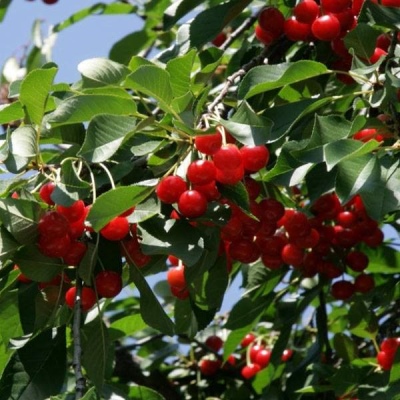
- Authors: folk selection
- Barrel type: bush
- Growth type: medium-sized
- Crown: sprawling
- Leaves: medium, dark green
- Fruit shape: rounded
- Fruit color: dark red
- Fruit weight, g: 6
- Pulp color : cream shade
- Pulp (consistency): juicy, crispy
When choosing a cherry tree for planting, every gardener is guided primarily by the following criteria - ease of care and good yield. Such varieties include Brusnitsyn cherry, which is a folk selection that even a novice gardener can grow.
Description of the variety
Cherry Brusnitsyna is a spreading bush that grows up to 2 meters in height in a favorable environment. The cherry bush is characterized by flexible skeletal branches and a strong thickening of bright green leaves that form a beautiful pyramidal crown shape.
Cherry bush blooms late - at the end of May. Inflorescences, consisting of 2-3 flowers, are formed directly on the shoots. The crown during this period is abundantly covered with large snow-white flowers that emit a pleasant aroma.
Fruit characteristics
Cherries of national selection are medium-sized. On a healthy tree, fruits gain a mass of 4-6 grams. The berries have a regular round shape with a perfectly smooth cover. Ripe cherries have a uniform dark red color without blotches. The cherry peel is dense, glossy, preventing cracking of the berries. The berry is torn off the stalk dryly, without violating the integrity of the cherry. The bone also separates from the pulp easily.
The harvested crop can be eaten fresh, used in cooking, cooked compotes, jelly, as well as canned, processed, frozen. Berries are transported well, without significant losses. In a cool place, cherries can be stored for about 3 weeks.
Taste qualities
The berries have good taste and marketability. The creamy flesh has a fleshy, tender, slightly crunchy, slightly fibrous and juicy texture. The fruit has a classic taste - sweet and sour, slightly refreshing, complemented by a subtle summer aroma. The pulp of berries contains about 15% sugars.
Ripening and fruiting
The early Brusnitsyn cherry is characterized by early ripening, delighting with a tasty and abundant harvest in the 3-4th year after planting. The berries ripen together, so it is recommended to harvest the crop in one day. Mass ripening of cherries occurs in mid-July.

Yield
Cherry Brusnitsyna is famous for its high yields. By providing a bushy fruit tree with intensive agricultural technology, you can count on a good harvest. On average, up to 20 kg of ripe berries can be harvested from 1 healthy tree.
Growing regions
The geography of growth of this culture has expanded significantly in recent years. In addition to the Urals, where Brusnitsyn cherry is very popular, the culture is grown in Siberia and warmer regions of the country.
Self-fertility and the need for pollinators
Cherries are self-fertile (about 40%), so additional cross-pollination is desirable. Donor trees are planted nearby and bloom at a similar time to Brusnitsyn cherry. The most effective pollinating trees are considered to be the Mayak, Besseya and Turgenevskaya varieties.
Landing
It is recommended to plant a cherry seedling in the spring, when the soil and air are well warmed up, but the growing season has not yet begun.The distance between plantings should be 3-4 meters so that there is no shading. As a planting material, it is recommended to choose a one-year or two-year seedling with a height of at least 60-80 cm.


Growing and care
For the cultivation of the Brusnitsyn cherry tree, a flat area with a small hill is being prepared, which is well illuminated by the sun. It is strictly forbidden to plant cherries in the lowlands, since stagnant water can destroy the root system of the tree. In addition, solanaceous crops, gooseberries and raspberries, as well as tall trees, the crowns of which can shade cherry plantations, are considered undesirable neighbors of cherries.
Cultural agrotechnics consists of such activities as watering, fertilizing, soil tillage, sanitary pruning, mulching, disease prevention and preparation for winter.
Watering is carried out every 14 days through trenches made around the tree trunk. Fertilizers are applied from the second year of the tree's life - in spring and autumn. The tree does not need to form a crown. The whitewashing of the trunk is carried out in early spring.


Disease and pest resistance
This variety is the owner of high immunity, therefore it is rarely susceptible to coccomycosis and moniliosis. Protection from the invasion of pests (fleas and ticks) will be provided by early spring treatment with special preparations.
Requirements for soil and climatic conditions
The tree is thermophilic, therefore it loves the sun and moderate moisture. It is also worth noting its high frost resistance, the ability to withstand short-term drought and heat.
When growing cherries, sandy loam, chernozem and loam with a minimum acid-base balance are ideal. The soil should be fertile, moist, breathable, loose and free from weeds. The passage of groundwater should be at a level of 150-200 cm.
































































